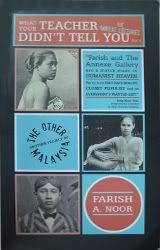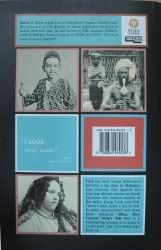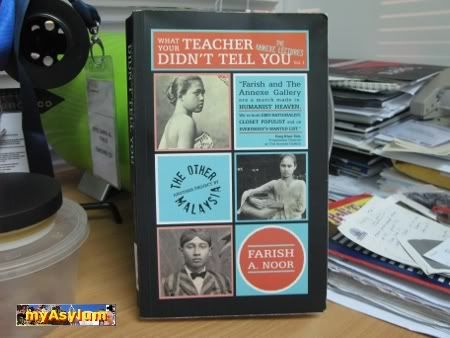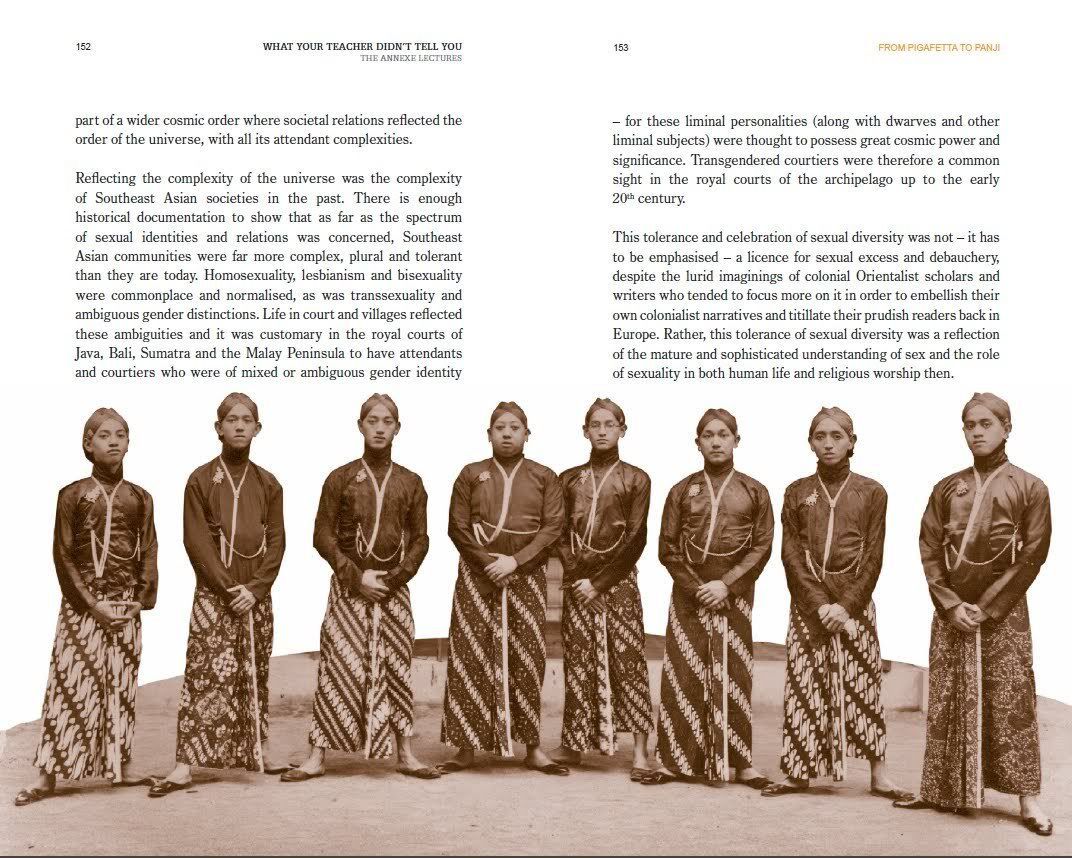Book Review: What Your Teacher Didn't Tell You
Technorati tags: History, Malaysia, Southeast Asia, Classic Literature, Politics, Farish Noor, Book Review
 What Your Teacher Didn’t Tell You: The Annexe Lectures (Vol. 1)
What Your Teacher Didn’t Tell You: The Annexe Lectures (Vol. 1)
Author: Farish A. Noor
Publisher: Matahari Books
ISBN: 9834484534
EAN: 9789834484538
Paperback, 288 pages
At one point or another, history would have been part of the curriculum we were exposed to in school. Walski has to admit that when he was in school, history was never a subject he liked. In retrospect, it’s probably because of how it is taught – when, where, who, and what being the four things stressed most.
And being that Walski didn’t really excel in those subjects requiring lots of memorization, he tended to avoid history. To his discredit.
But that has changed over the last decade or so – and one of the reasons for that change has been Walski’s exposure to the many untold stories about our collective history – that of our nation, as well as that of the immediate region our country resides in. Things his teachers never told him about. And perhaps one of the most important sources of these obscured stories, as far as Walski’s concerned – Farish A. Noor.
It is unfortunate that the national and regional history most of us would have typically been exposed is quite rigid, and told from a rather narrow, and sometimes selfish, perspective. But this book aims to open our eyes to history that has been, for the most part, obscured, untold and, to some extent, withheld.
This book is a compilation of five Central Market Annexe lectures, delivered by Malaysia’s hippest academician, Farish Noor, between March 2008 and September 2009. Walski was fortunate enough to attend one of them, which appears as the second chapter in this book (“The Lost Tribes of Malaysia”).
But believe you Walski when he says this – if there were to be one, and only one, book you read this year, you need to make sure that it’s What Your Teacher Didn’t Tell You.
(history obscured and withheld, and more, in the full post)
So, why is this book so important? Before we delve into that in more detail, perhaps a look at why this book was put together might be useful, as a prelude to answering the question.
In the Introduction, Farish outlines two reasons why this book was published, and why (in Walski’s opinion) every Malaysian should read it. Firstly, there is (emphasis by myAsylum)
"...the urgent need for Malaysians to reclaim the histories, biographies, symbols, tropes, and markers that dot the narrative and discursive landscape of Malaysia from the clammy clutches of politicians, ideologues and soapbox orators who would otherwise be inclined to reduce the semiotic repertoire of our public discursive domain to simplified and essentialised totems that stand for a communitarian and divisive politics that is not only historically inaccurate, but politically dangerous."
(Introduction, pp. 12 - 13)
 Simply put, what we know of our past has been oversimplified and condensed into a mould meant to serve ulterior and narrow political motives. For example, little, if any, is ever spoken about the influences of Hindu and Buddhist cultures that have actually played a major role in forming what we know as “Malay” culture today. Similarly, the notions that Chinese and Indians only appeared on our landscape during late colonial times, as recent social ingredients that have made Malaysia multicultural – notions that play very well into the exclusivist political rhetoric that we hear all too often today in our nation.
Simply put, what we know of our past has been oversimplified and condensed into a mould meant to serve ulterior and narrow political motives. For example, little, if any, is ever spoken about the influences of Hindu and Buddhist cultures that have actually played a major role in forming what we know as “Malay” culture today. Similarly, the notions that Chinese and Indians only appeared on our landscape during late colonial times, as recent social ingredients that have made Malaysia multicultural – notions that play very well into the exclusivist political rhetoric that we hear all too often today in our nation.
The second reason why this book is important, is that our obscured history has for too long been only available, for the most part, to the academicians. Hence, the uniqueness of where this wealth of information was initially presented to the general public.
"... these lectures were delivered at Central Market Annexe Gallery with the intention of proving a point that ought to be made time and time again: that academia is not to be confined within the hallowed precinct of universities solely, but rather that knowledge-production is something that takes place in the social arena"
(Introduction, pg. 14)
In other words, the intent of this compilation is also to make our obscured histories accessible.
And what important information does this book make accessible to us?
As Walski had mentioned earlier, What Your Teacher Didn’t Tell You is a compilation of 5 lectures Farish delivered at the Central Market Annexe Gallery. It also includes one interesting “Bonus Chapter”.
The book starts off by lamenting what today is probably best known as an icon of “Ketuanan Melayu” – the keris – that wavy dagger often flayed around by certain politicians in heat. In “Pity The Poor Keris”, Farish walks us through the long, almost 2 millennia-old, history of a thoroughly misunderstood cultural icon. And in doing so, we begin to see how Hindu/Buddhist cultures of old have contributed to a culture most of us identify as having been “always” Islamic in origin and nature – the “Malay” culture.
“Pity The Poor Keris” urges us to rediscover the blade’s multifaceted cultural origins, in an attempt to understand how our own culture evolved over the many centuries. The keris, as we discover, is much more than just an instrument of violence. And through our journey, we also discover how metropolitan our region was prior to the arrival of Western colonialists, whose biggest contribution is perhaps in how their then world-view has been transplanted to shape our own popular image of regional and national history.
But far from being blindly anti-colonial and anti-West, What Your Teacher Didn’t Tell You is objective in it’s criticism of colonial empire-building, and the many side-effects thereof. And it’s exactly this critical rediscovery and rereading of history that Farish tries to impart on his readers.
Perhaps the most pertinent chapter in helping us understand the socio-political dichotomy of Malaysia today, is the second chapter, entitled “The Lost Tribes of Malaysia”, which interestingly enough, is sub-titled ‘The Construction of Race Politics from Colonial Era to The Present’’. Interesting, because it is in this chapter that we discover how the multitudes of diverse and rich cultures present in the 19th century were gradually distilled to become the Malay/Chinese/Indian/Others demographics we know today.
Reading this chapter, you’ll immediately understand why Walski usually writes the word “Malay” enclosed in quotes.
And Walski is probably not exaggerating when he says that it is exactly this very over-simplified dichotomy that Malaysians today, at large, accept as “naturally” the way things have always been, and should forever be. Reading the book, however, we discover that the historical facts are actually furthest away from this popular notion, that we’ve been programmed to accept as the only possible reality.
 Walski's copy of the book, which admittedly has seen better days!
Walski's copy of the book, which admittedly has seen better days!
The next chapter, “Of Rajas, Maharajas, Dewarajas and Kerajaan”, is equally relevant to our Malaysia today. For in it, we discover the four thousand year old reason why we remain somewhat feudal in our outlook. At the very least, it finally convinces Walski that old habits are indeed hard to break. Particularly when those habits are ones that we ourselves subconsciously nurture.
“From Pigafetta to Panji”, a lecture originally delivered on August 31, 2008, departs from the political somewhat to dispel the idea that certain behaviors deemed reprehensible by our religious authorities and moral guardians, like the “shocking phenomena” of lelaki lembut and tomboy-ism, for instance, are not alien and/or Western-influenced evils. In fact, this interesting foray into the history of Southeast Asian sexuality tells us quite the opposite – that homosexuality and gender-bender scenarios are, in fact, very much part of our “Asian values”, seen from an historical perspective.
The final chapter in the book is a critical analysis of another misunderstood and purposefully misrepresented icon – the legendary Hang Tuah. Farish, in this chapter, reveals to us that the so-called ideal and unquestioning Malay warrior, the image of Tuah that has become a favorite fodder of modern-day exclusivist ethno-nationalists, had a totally different, and Walski dares say, more important, side to him - “Hang Tuah The Pacifist”.
Using Kassim Ahmad’s compilation of Hikayat Hang Tuah as reference (one that is admittedly the most complete and authoritative), Farish walks us through the second part of the Hang Tuah epic – one that is very rarely mentioned.
"Sadly, most Malaysians today have yet to read the Hikayat Hang Tuah in its entirety, and many do not even realise that the most common versions of the story that we know (particularly the more plebeian renderings of the tale dished out to us thanks to the modern miracle of cinema) are incomplete. In fact, most Malaysians remain blissfully unaware of the second part to the Hang Tuah epic, where Tuah the warrior assumes a different role altogether, as the emissary of Melaka to foreign lands."
(from Hang Tuah The Pacifist, pg. 242)
And equally as sad, Walski will have to admit that he, too, is part of that “most Malaysians” demographic (although he does intend to remedy this inclusion in the very near future).
To Walski, the second part of the Hang Tuah epic is important because it gives a totally new perspective to the oft-quoted and over-used “tak kan Melayu hilang di dunia” (‘never will the Malays perish’). This new perspective provides a renewed hope that all is not lost, when it comes to our nation, and that there is historical precedence for positive change. And it is with this important point that Farish closes the chapter, and the book.
Nestled between the fourth chapter (“From Pigafetta to Panji”), and the last, is the bonus chapter mentioned earlier – “The Red-Green Alliance” which unlike the other chapters, did not originate as an Annexe lecture. It is, in fact, a look at what Farish calls ‘the left-leaning years’ of the Pan-Malaysian Islamic Party, which we today know better as PAS.
What Walski found interesting about this bonus chapter is two-fold – first, that PAS today is not the same PAS that was formed in 1951, nor was it the same party in existence in 1956 to 1969, the period which this chapter focuses on, by examining the life of the party’s third president, Dr. Burhanuddin al-Helmy. Second, that it isn’t only the Alliance/BN continuum that can lay exclusive claim to the credit of fighting for an independent Malaya. An important what-if that arises from reading this chapter: this would have been a totally different Malaysia if our British colonialists had been more receptive to the demands of other political entities of the time.
And therein lies the importance of this book: to understand why we are the way we are today, it’s imperative that we know the history of how we came to this point in our collective existence. But not just the official and popular narratives of history, taken at face value – it’s equally important to learn and understand alternative views of history, told either from different perspectives, or through the lens of society at the time – made possible by examining the writing and literature of the time. This analysis and
Only when we fully understand ourselves can we hope to create a framework and road map to a better collective future. Relying solely on the status quo will only take us where the status quo wants us to – which is not always a desirable destination.
It is therefore for these reasons that Walski strongly recommends this book to anyone who cares about this nation, and would like to help build a stronger country for our future generations.
And if these reasons on their own aren’t important enough, and the fact What Your Teacher Didn’t Tell You is a book that’s been beautifully and artistically put together should be an added bonus. Walski will tell you that publisher Amir Muhammad does not exaggerate when he said that it is, by far, “the most gorgeous book we have produced". Credit goes to Liza Manshoor (of Eclectic Design) for making the book a visual masterpiece – the beautiful layout added to making the book not just an important read, but a joyful literary experience on top of that.
 Pages 152/153 of the book - image taken from Writing by Amir
Pages 152/153 of the book - image taken from Writing by Amir
As another added bonus (assuming you’re still not sold on the book), law professor Azmi Sharom (another hip Malaysian academician, whose bi-weekly column Brave New World is published by The Star) contributes a preface piece, about the important role of the academician – a role that is unfortunately very much undervalued in our current socio-political climate.
Perhaps the only very minor fault that Walski could find with What Your Teacher Didn’t Tell You is that the footnotes, liberally found throughout the book, can get a tad distracting. That said, these footnotes are a necessary distraction, providing insightful perspectives and sources for further reading. A friend of Walski’s did remark, though, that he thought the book read a bit too much like a history textbook.
A history textbook it may be, but it’s like no other textbook you’ll ever find. The engaging and eye-opening content, coupled with the aesthetically pleasing sepia-toned historical imagery artistically chosen to accompany the worthwhile text, plus the unique thick-cut paper used, making sure that the meaty text physically feels meaty, all come together to make Farish A. Noor’s What Your Teacher Didn’t Tell You a must-read for 2010.
~ ~ o O 0 O o ~~
Walski's Technical Publishing Additional Information Footnote: Walski had the opportunity to briefly converse with Amir Muhammad (founder of Matahari Books, the publisher) on Twitter the other day. He mentioned that What Your Teacher Didn’t Tell You is already in it’s FOURTH edition (as of April 2010), and is a certified best-seller. That is indeed heartening to note, since Walski personally feels that this is a very important read for all Malaysians, no matter where you may be.
You can find this book in all major bookstores around the country and in Singapore, and also online, through Amazon.com. And just in case you’re wondering about Volume 2, Amir said that it would be published sometime in December this year, God-willing.


![Reblog this post [with Zemanta]](http://img.zemanta.com/reblog_e.png?x-id=6d6382a5-a689-4780-addb-b1d1ebb55304)














